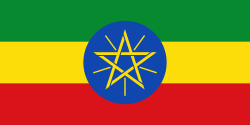Flag of Ethiopia facts for kids
The flag of Ethiopia is a very important symbol for the country. It was officially adopted in 1996. A country's flag tells a story about its history, values, and hopes for the future. Ethiopia's flag is known for its unique colors and the special emblem in the middle.
Contents
The Ethiopian Flag
The flag of Ethiopia features three horizontal stripes: green at the top, yellow in the middle, and red at the bottom. These colors are very significant in Ethiopian culture and history. In the center of the yellow stripe, there is a blue circle with a golden pentagram (a five-pointed star) and five rays of light shining from it.
What the Colors Mean
Each color on the Ethiopian flag has a special meaning:
- Green often represents the land, its fertility, and the hope for the future. It can also symbolize the hard work and development of the country.
- Yellow stands for peace, harmony, and justice. It also represents the country's natural wealth and resources.
- Red symbolizes strength, sacrifice, and the blood shed by heroes who defended Ethiopia's freedom and independence.
The National Emblem
The blue circle in the middle of the flag represents peace and democracy. Inside this circle, the golden pentagram, or five-pointed star, is a symbol of the unity of the people and nationalities of Ethiopia. The rays of light shining from the star show a bright future and prosperity for the nation. This emblem is called the National Emblem.
A Short History of the Flag
Ethiopia is one of the oldest independent countries in Africa, and its flag has a long history. The colors green, yellow, and red have been used in Ethiopian flags for many years, even before 1996. These colors became very famous and were even adopted by other African nations after they gained independence. This is why they are sometimes called the "Pan-African colors." The current design, with the specific emblem, was adopted to represent the modern Ethiopian state and its commitment to unity and peace among its diverse people.
Images for kids
See also
 In Spanish: Bandera de Etiopía para niños
In Spanish: Bandera de Etiopía para niños



